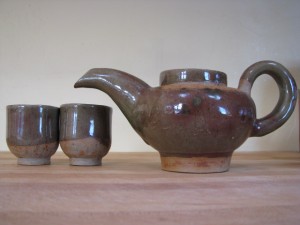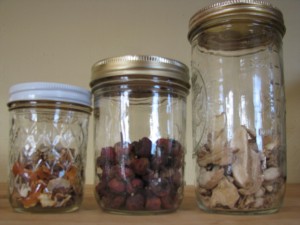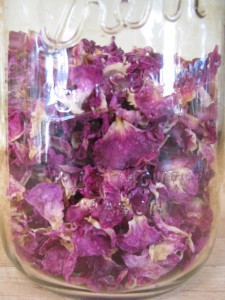
gorgeous ceramics by Kevan Miller
To listen to a related radio broadcast, go to http://www.kpfa.org/archive/id/66958 . This program aired live on January 20, 2011 and will be archived for two weeks.
If you don’t already make herbal teas for yourself, now is a good time to start. Since we are supposed to slowing down during winter, taking the time to make some tea, that is not only warming but good medicine, is a great way to get in the mood of winter. Then when the different seasons roll around, you have your tea making skills down and all you need to do is make seasonal adjustments for the herbs you are using.
Making herbal tea is making medicine. You’ll hear about herbal infusions and herbal decoctions, more about that later. For the sake of brevity, I’ll just refer to all of them as tea. I’m not talking about throwing an old chamomile tea bag in some hot water for five minutes. This time-honored method makes a lovely beverage, but it is not medicine. I’m talking about using good quality, loose, dried herbs and giving them hours to steep in water.
Some hints about selecting and storing your herbs:
Once herbs are dried they lose their stability after one to two years – this varies from plant to plant. When buying loose, dried herbs check for freshness. They should have some color to them, some smell. Old dried out herbs have no life. Even if you don’t know what the plant is supposed to look or smell like, you can get a sense of whether the herb has some vitality to it. Think about selecting produce.
If you are going to use your herbs in a timely manner – within a couple months – store them in a covered glass jar in your cupboard. If you buy a large quantity and/or do not use them often, put them in a plastic freezer bag and store in your freezer. Storing herbs in your freezer will help them to maintain their freshness.
So, let’s get started:
you will need a clean, empty quart-sized glass jar with a lid (mason jar or large mayo jar; a wide-mouth jar is easiest to work with)
put 1 to 2 handfuls of dry herb in the jar (or about two to three inches deep, this will vary depending upon the fluffiness of the herb)
heat water on stove to hot, just before a boil
pour water into jar filling it, covering the dry herb, cover with the lid to the jar (do not tighten it however, or it will be difficult to unscrew once it cools)
allow to steep (sit covered) for a minimum of 8 hours to overnight
once the tea has steeped, strain out plant matter (if you are able, it is nice to put the plant matter, called the mark, in your garden under a tree or plant, so that it can return to the earth; when I didn’t have a yard and lived in the city, I liked to take the mark out and put it under one of the city trees surrounded by concrete.)
drink and enjoy your tea; drink at room temperature or gently warm on the stove (do not boil and do not microwave)
store tea in the refrigerator for 2 to 3 days; if you haven’t finished it by this time pour it out, it will start to grow things
if you want to make a smaller amount of tea, use about one table spoon dry herb to 8 ounces of water and follow the previous steps.
Additional tips:
If you are making a tea combining several herbs, it is easiest to mix the dry herbs together in a large bowl and store them already mixed. Then you can simply grab a handful of the mix and make your tea.
If you like to make your own blend each time, still follow the above guidelines for herb to water proportions. In other words, if you are combining three herbs into one tea, do not put two handfuls of each herb in the jar. Also, it is easier to brew them together, rather than having three separate jars going if you are planning to drink them together anyway.
Whether you are making teas for health for pleasure or both, enjoy them. Take time to enjoy the ritual of making the tea, appreciate the colors, aromas and tastes.
Here are some herbs you might want to try. Making tea blends is a lot like cooking, from a flavor standpoint. And sometimes, you aren’t as concerned about the flavor and just want to get the medicinal properties into your body. I didn’t include any herbs below that most people might consider ‘bad’ tasting, just to ease you in to the whole tea thing.
mullein leaves – wonderful respiratory tonic, especially to the lungs (This one I like to strain through a cloth or coffee filter so the little hairs on the leaves don’t irritate your throat.)
chamomile flowers – calming, helps with anxiety, especially when felt in stomach area, good digestive aid as well
burdock root – good liver and digestive support
hawthorne berries– wonderful heart tonic, high in bioflavinoids and help lower cholesterol
elder berries – strongly anti-viral specific to the respiratory system, good medicine for the cold and flu season
So, about infusions and decoctions. An infusion is what is described above in your tea making process. Infusions are great for leaves and flowers. When making tea from denser plant matter such as roots and berries, herbalists often make a decoction. For a decoction you would first lightly simmer the herbs, covered, for 20 minutes to several hours. Then you let it steep as described above in a covered jar. That being said, sometimes you are mixing leaves and roots, for instance. In that case you can separate them and add the decocted roots into you infusing leaves, or you can keep is simple and just infuse the whole blend.
Herbal teas are a lovely way to introduce people, including yourself, to herbal medicine. You can work with different blends, like you blend flavors when you cook. Sometimes, I like to just make a tea of one herb to really enjoy the taste and energy of that one plant and its medicine. Here is enough information to get you started. Heat up some water and get your jar out, get your hands in some herbs and before you know it, you’ll be sitting with a nice warm cup of medicine watching the winter sunset.
Be well,
Sarah

